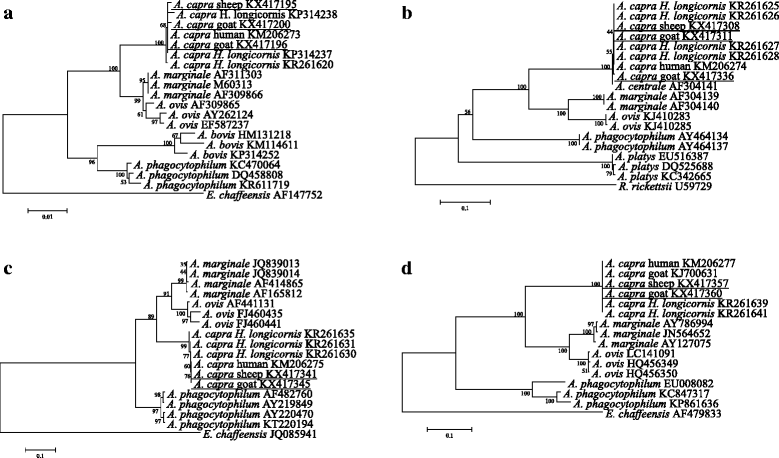A novel zoonotic Anaplasma species is prevalent in small ruminants: potential public health implications
- PMID: 28558749
- PMCID: PMC5450374
- DOI: 10.1186/s13071-017-2182-9
A novel zoonotic Anaplasma species is prevalent in small ruminants: potential public health implications
Abstract
Background: Tick-borne diseases currently represent an important issue for global health. A number of emerging tick-transmitted microbes continue to be discovered, and some of these are already identified as the cause of human infections. Over the past two decades, Anaplasma phagocytophilum is considered to be mainly responsible for human anaplasmosis. However, a novel zoonotic pathogen provisionally named "Anaplasma capra" has recently been identified in China. In this study, we did an active surveillance of A. capra in goats and sheep in different geographical regions of China.
Methods: The presence of A. capra was determined by nested PCR in 547 blood samples collected from goats and sheep from 24 counties distributed in 12 provinces in China. The molecular characterization of A. capra isolates in sheep and goats was achieved based on four conventional genetic markers (16S rRNA, gltA, groEL and msp4 genes).
Results: Anaplasma capra was identified in 75 of 547 animals, with an overall prevalence of 13.7%. The infection rates in the survey sites ranged from 0 to 78.6%, and were significantly different (P < 0.01). Phylogenetic analysis revealed that the isolates obtained from goats, sheep, Ixodes persulcatus ticks and humans create a separate clade within the genus Anaplasma and distinct from other recognized Anaplasma species. These findings indicated that these A. capra isolates possess the same molecular characteristics, suggesting that this organism could be a substantial health threat to both animals and humans.
Conclusions: Anaplasma capra is an emerging tick-transmitted zoonotic pathogen. This novel Anaplasna species is widespread across China with an overall prevalence of 13.7% in goats and sheep with isolates indistinguishable from those found in humans. These findings warrant increased public health awareness for human anaplasmosis.
Keywords: 16S rRNA gene; Anaplasma capra; Anaplasmosis; Prevalence; Public health; gltA gene; groEL gene; msp4 gene.
Figures

Similar articles
-
Anaplasma capra: a new emerging tick-borne zoonotic pathogen.Vet Res Commun. 2024 Jun;48(3):1329-1340. doi: 10.1007/s11259-024-10337-9. Epub 2024 Mar 1. Vet Res Commun. 2024. PMID: 38424380 Free PMC article. Review.
-
Detection and Phylogenetic Characterization of Anaplasma capra: An Emerging Pathogen in Sheep and Goats in China.Front Cell Infect Microbiol. 2018 Aug 30;8:283. doi: 10.3389/fcimb.2018.00283. eCollection 2018. Front Cell Infect Microbiol. 2018. PMID: 30214896 Free PMC article.
-
Molecular surveillance based on anaplasmosis in domestic small ruminants: First report on zoonotic Anaplasma capra and phylogenetic insights from Faisalabad, Pakistan.PLoS One. 2024 Sep 6;19(9):e0305412. doi: 10.1371/journal.pone.0305412. eCollection 2024. PLoS One. 2024. PMID: 39241048 Free PMC article.
-
Differential identification of Anaplasma in cattle and potential of cattle to serve as reservoirs of Anaplasma capra, an emerging tick-borne zoonotic pathogen.Vet Microbiol. 2018 Nov;226:15-22. doi: 10.1016/j.vetmic.2018.10.008. Epub 2018 Oct 11. Vet Microbiol. 2018. PMID: 30389039
-
Anaplasma spp. in North Africa: A review on molecular epidemiology, associated risk factors and genetic characteristics.Ticks Tick Borne Dis. 2018 Mar;9(3):543-555. doi: 10.1016/j.ttbdis.2018.01.003. Epub 2018 Feb 3. Ticks Tick Borne Dis. 2018. PMID: 29398602 Review.
Cited by
-
Anaplasma capra: a new emerging tick-borne zoonotic pathogen.Vet Res Commun. 2024 Jun;48(3):1329-1340. doi: 10.1007/s11259-024-10337-9. Epub 2024 Mar 1. Vet Res Commun. 2024. PMID: 38424380 Free PMC article. Review.
-
Dogs as New Hosts for the Emerging Zoonotic Pathogen Anaplasma capra in China.Front Cell Infect Microbiol. 2019 Nov 26;9:394. doi: 10.3389/fcimb.2019.00394. eCollection 2019. Front Cell Infect Microbiol. 2019. PMID: 31850236 Free PMC article.
-
Molecular detection and identification of tick-borne bacteria and protozoans in goats and wild Siberian roe deer (Capreolus pygargus) from Heilongjiang Province, northeastern China.Parasit Vectors. 2019 Jun 13;12(1):296. doi: 10.1186/s13071-019-3553-1. Parasit Vectors. 2019. PMID: 31196180 Free PMC article.
-
Diversity of Rickettsiales bacteria in five species of ticks collected from Jinzhai County, Anhui Province, China in 2021-2022.Front Microbiol. 2023 Apr 28;14:1141217. doi: 10.3389/fmicb.2023.1141217. eCollection 2023. Front Microbiol. 2023. PMID: 37187539 Free PMC article.
-
Evidence of Ehrlichia chaffeensis in Argentina through molecular detection in marsh deer (Blastocerus dichotomus).Int J Parasitol Parasites Wildl. 2018 Dec 17;8:45-49. doi: 10.1016/j.ijppaw.2018.12.004. eCollection 2019 Apr. Int J Parasitol Parasites Wildl. 2018. PMID: 30619709 Free PMC article.
References
MeSH terms
LinkOut - more resources
Full Text Sources
Other Literature Sources
Medical
Research Materials
Miscellaneous

